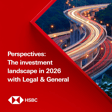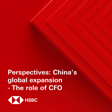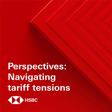Become a Creator today!Start creating today - Share your story with the world!
Start for free
00:00:00
00:00:01

Under the Banyan Tree – A macro whip round the region
Fred has the studio all to himself, and that can only mean one thing: a comprehensive review of the key talking points shaping Asian economics from tariffs to central bank action and, of course, AI.
Disclaimer: https://www.research.hsbc.com/R/101/xglRmRg
Stay connected and access free to view reports and videos from HSBC Global Investment Research, just search for #HSBCResearch on LinkedIn or click here: https://www.gbm.hsbc.com/insights/global-research.
Transcript
Introduction to HSBC Global Viewpoint Podcast
00:00:01
Speaker
Welcome to HSBC Global Viewpoint, the podcast series that brings together business leaders and industry experts to explore the latest global insights, trends, and opportunities.
00:00:13
Speaker
Make sure you're subscribed to stay up to date with new episodes. Thanks for listening, and now onto today's show.
00:00:24
Speaker
This is a podcast from HSBC Global Investment Research recorded for publication on Thursday the 9th of October. Analystifications, disclosures and disclaimers must be viewed on the link attached to your media player.
Solo Hosting: Fred Newman's Overview of Asia Economics Quarterly
00:00:45
Speaker
Welcome to Under the Banyan Tree. I'm your host, Fred Newman, Chief Asia Economist at HSBC here in Hong Kong. My regular co-host Harold is out of town this week, so it's just me here in the studio, but there's a lot to cover.
00:00:57
Speaker
We recently published our Asia Economics Quarterly, and I want to talk through some of the highlights with you on the podcast today. We're going to whip around the whole region, zooming in on the key macro talking points from tariffs to central banks, AI to easing measures. Plenty to chew on, and it's all coming up right here Under the Banyan
How Do US Tariffs Impact Asian Economies?
00:01:15
Speaker
Tree.
00:01:15
Speaker
you
00:01:26
Speaker
So we want to start with tariffs, tariffs, tariffs. They've obviously been the headline over the summer, and that's a really existential issue for Asian economies because the region's prosperity was built on exports. Globalization really helped Asia. In fact, Asia defined globalization in many ways in recent decades. But with U.S. tariffs kicking in, that poses a significant headwind for Asian economies and even raises questions about the future growth structure.
00:01:56
Speaker
Now, what is the exact impact of these tariffs? There's a lot to consider here. One is, of course, that export volumes are going to slow ah fewer shipments into the U.S. at some point.
00:02:08
Speaker
And then there's also the impact on investment that many people often overlook because a lot of the manufacturing investment here in the region is tied to exports to the United States. So it's both an export volume issue as well as an investment drag that we expect to come through. now the impact for the average economy in Asia is probably going to be about half a percentage point of
Varied Tariff Impacts Across Asia
00:02:32
Speaker
GDP growth. So if you think about this over next 12 months, because of these tariffs, likely the average economy in Asia will see a 0.5 percentage point reduction in GDP growth as a result of these tariffs.
00:02:47
Speaker
And that's just a 12-month impact. Then further out, you can also then say, well, if these tariffs remain in place, um there's going to be a permanent impact on Asian growth because there's less productivity growth, ah less growth opportunities by shipping goods to the U.S. And that will be about 0.2 to 0.3 percentage points for each economy on average. now Averages obviously gloss over some of the nuances. If you think about ah which economies are most exposed to this, China probably tops the list here.
00:03:20
Speaker
By our estimates, the impact on Chinese growth is going to be about one percentage point. So if the economies say... were supposed to grow or expect to grow 5%. It would now grow at 4% as a result of these tariffs, of course, unless the government unleashes other stimulus measures.
00:03:36
Speaker
But then you have economies like Australia, for example, where the impact is really minimal because Australia doesn't really ship that much to the U.S. s and here the estimated impact is about 0.1%. And most other economies are somewhat in between. You get sort of India at 0.7%. You get Japan 0.4, 0.5 percentage points.
00:03:55
Speaker
So we're kind of in between. ASEAN generally bound to 0.6. So this is how economies stack up. So that's the first point to make. Undoubtedly, there's going to be some impact on growth
The Shifting Competitive Landscape
00:04:06
Speaker
across the region. But the other discussion around tariffs is who's going to win from these tariffs? Because in the first Trump administration, we saw...
00:04:15
Speaker
are certainly economies like Vietnam benefiting because China received tariffs. And so some industries move from China to Vietnam. And actually, on a net basis, Vietnam probably benefited a little bit from these tariffs that the U.S. imposed on China. But this time around, who's going to be the winners?
00:04:31
Speaker
And actually, probably not that many economies, if any, because everybody received tariffs from the U.S. And so there's no big relative tariff advantage that anybody has.
00:04:42
Speaker
So ah Vietnam this time around received around 20%. Most Southeast Asian economies received about 20 percentage point tariffs. And so there's not really a big shift in relative competitiveness. Now, you could say, well, if China has much higher tariff than ah Vietnam has, but you also have to take into account that China is still vastly competitive. So that 10 percentage point, 15 percentage point advantage that Vietnam might have over China is not big enough to really shift our supply chain in a major way. So um there is firstly going to be a growth impact on the region.
From Exports to Domestic Growth: A Necessary Shift?
00:05:18
Speaker
And the second point is really we're probably not going to see that much of a shift in supply chains across the region.
00:05:25
Speaker
But that's really sort of the impact over the next 12 months, say. But keep in mind that really longer term also, ah if we have a retreat from globalization, if the U.S. maintains these very high tariffs, maybe other countries start to join ah raising tariffs as well, that's going to be tough for Asian economies. They really have to think about the structure of economic growth.
00:05:46
Speaker
because you can't rely on exports as much to fuel your economies and need to shift more towards the domestic side. So these are some of the aspects we discuss in this report. And and I think it's worth to really delve a little bit deeper here and kind of see at what the nuances are. But no doubt these tariffs are a challenge.
China’s Growth Slowdown and the Call for Fiscal Stimulus
00:06:05
Speaker
Now, what else ah do we discuss in this report? Another big, big area is, of course, China. China's had a fairly good run in growth for first half of this year, growing around 5.3%, which was probably better than most people had expected the beginning of the year.
00:06:21
Speaker
But then there was a sudden shift lower in activity in July and August. Very suddenly, the economy started to cool again, putting some of those growth gains the first half of the year in question. And If you look at the numbers in July and August, you see there was a fairly broad-based deceleration. It wasn't just one particular sector, say, infrastructure. No, it was manufacturing investment. It was retail sales. It was even signs that exports are going to slow.
00:06:49
Speaker
So all of this suggests there's a broad-based deceleration in China. And that means that there is really need to put in more stimulus again in the Chinese economy because if you have a renewed slowdown in growth and you're going to see an even bigger drag from exports, that would sort of accentuate some of the deflationary pressures or some people call it disinflationary pressures in mainland China. and And of course, that's a risk for the Chinese economy. Prices continuing to fall. That's generally not considered good for economic growth because it kind of disincentivizes investment. It means that profit growth is slowing. And so there is a clear need here to dial up the stimulus.
00:07:34
Speaker
And we're often asked, what could the Chinese authorities really do to dial up stimulus? And um the The answer remains primarily fiscal easing. You need to put more fiscal resources to work, ideally shoring up consumer spending with fiscal stimulus, but also providing sufficient funds to local governments, which...
00:07:55
Speaker
account for 80% of infrastructure spending in China. And so if they don't have enough funds, then they will slow down infrastructure spending that weighs on growth. And so fiscal policy very much remains in the spotlight main in China. But we should also say that deflation in China or disinflation in China is not just a challenge for the Chinese economy. It remains a challenge for the global economy. And that is because the disinflation in China the excess capacity ultimately kind of ah it permeates out to the rest of the world economy. It's being exported by China. What we mean by this is that the ah the falling prices in China ultimately find their way through falling export prices and that puts pressure on manufacturers elsewhere in the global economy,
Monetary Policy Adjustments in Asia
00:08:42
Speaker
particularly economies that don't have tariffs yet on on mainland China. Think about Europe, for example. Think about Southeast Asia.
00:08:48
Speaker
And that's why this question around the stimulus in mainland China is of importance, not just for Chinese growth, but really matters to the world at large to alleviate some of the disinflationary pressure that is is coming through. Now, what's our view here? We do think there's going to be more fiscal easing coming through.
00:09:07
Speaker
But if you look at our growth forecast, we still think that next year's growth in mainland China will be slightly below average growth this year because the headwinds are just enormous. And they they stem in part from ah still a property market that continues to deflate and that has some challenges.
00:09:26
Speaker
So that's the second big area we we discuss. and And that leads me to the third area. And that is really the pressure on central banks in Asia to kind of stem this these headwinds on growth both on the export side because of tariffs in the US s and from ah kind of weaker Chinese growth and that means central banks across much of Asia will have to cut interest rates. Now fortunately There's very little by way of inflationary pressures. Energy prices are lower. Food prices are fairly stable as well. And we're seeing core inflation very well behaved, partly because China is exporting cheap goods to the rest of the region. It's kind of anchoring ah inflation lower. And the market is currently not pricing in much by way of rate cuts in Asia.
00:10:12
Speaker
um But we think actually there is probably an argument here for central banks to continue to ease monetary policy in most of emerging Asia. Japan is a bit of an exception here, but certainly in the rest of the region there needs to be much more monetary easing to prevent a sharper slowdown in economic growth.
00:10:32
Speaker
So these are some of the the headwinds we face in the Asian economies, certainly exports, are certainly weaker Chinese growth, and and their solution here is to cut interest rates more.
AI Hardware: A Bright Spot in Asia's Economy
00:10:43
Speaker
But I want to take a quick break, and when we come back, I want to look at one of the areas where there's actually a bright spot still in Asia um that's certainly lifting growth in some of the key economies.
00:11:03
Speaker
Welcome back everybody. Now before the break we discussed some of the headwinds that Asian economies face including slower exports to the United States and still disinflationary pressures from mainland China.
00:11:15
Speaker
um But there's one area really that's been doing quite well of late and it seems to be immune to these headwinds in growth and that is the enormous amount of global AI hardware investment that we're seeing, particularly if you think about Korea, for example, if you think about Taiwan, um all the high-end chips that are going into the US but also globally into data centers, that's been off the charts, they've been single-handedly driving economic growth. And Taiwan, for example,
00:11:44
Speaker
ah We're looking at over 5% GDP growth this year, largely fueled by this boom in AI hardware. As I said, Korea benefits from that, but also in Japan, we're seeing signs that actually the AI hardware boom is driving investment. In Malaysia, for example, we see enormous investments in data centers coming through, so it's not necessarily...
00:12:06
Speaker
um the production of semiconductors in Malaysia, but it's really the investment in data centers that ultimately benefits the Malaysian economy. And even Thailand has actually benefited because Thailand is one of the key producers globally of hard disk drives and the boom in AI, but also in data centers generally and the the need for ah data storage has started to lift suddenly the demand for hard disk drives. And so even there we see quite a bit of demand coming through. And if you look at projections of particularly large US companies about the investment projections over the next few years, ah it looks like for the time being that boom at least ah will continue. And given the importance to Asian electronic supply chains, at least here,
00:12:49
Speaker
there's something positive to take away and that for some economy certainly provides a bit of a leg to stand on, even if we'd grapple with higher US tariffs and disinflationary pressures in China.
Conclusion and Next Week's Tease
00:13:00
Speaker
So that's it, folks. I hope you get a chance to check out this report and or you found this summary useful. We have to leave it here. Thank you, as always, for tuning in. Harold will be making a return to the airwaves next week, and we look forward to talking to you then.
00:13:13
Speaker
Until then, do listen, like, and subscribe to our sister podcast, The Macrobrief, if you haven't already. Have a great rest of the week, and we'll be back again soon.
00:13:45
Speaker
Thank you for joining us at HSBC Global Viewpoint. We hope you enjoyed the discussion. Make sure you're subscribed to stay up to date with new episodes.










